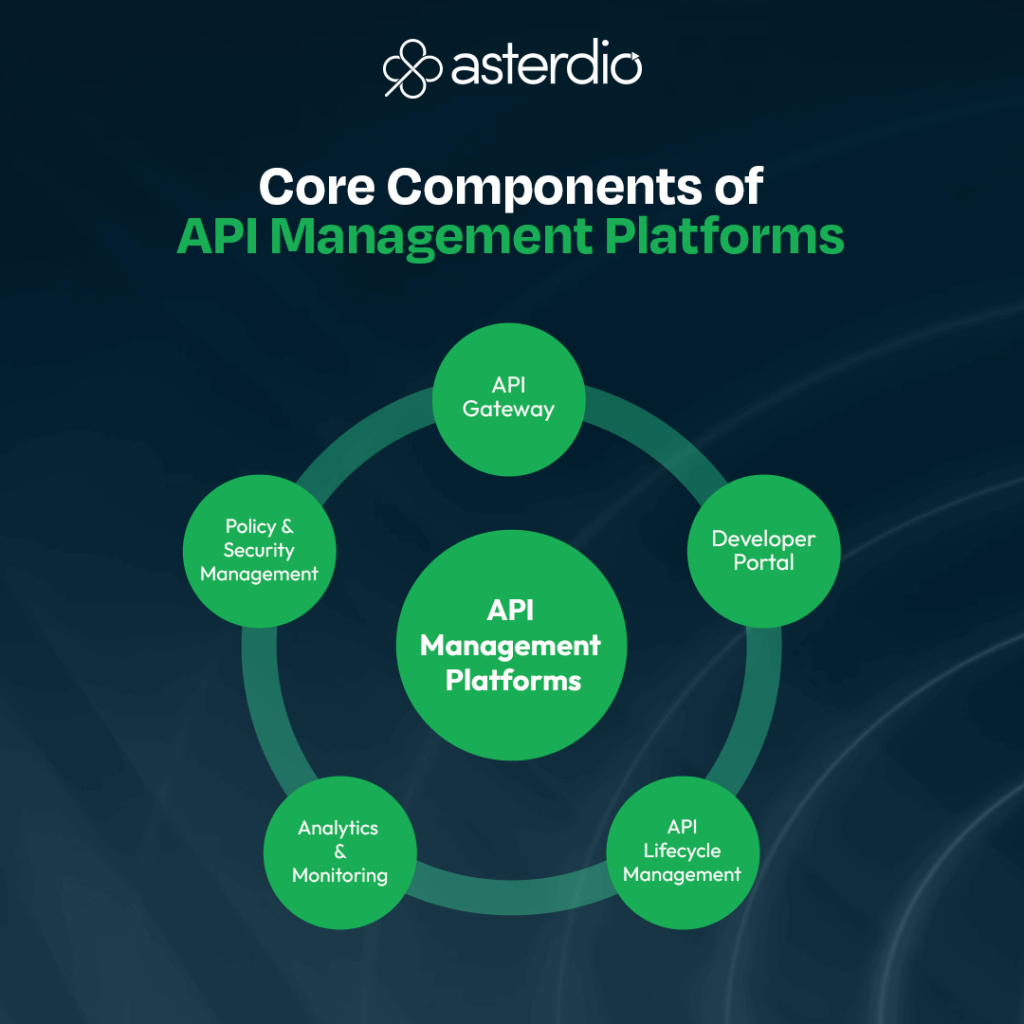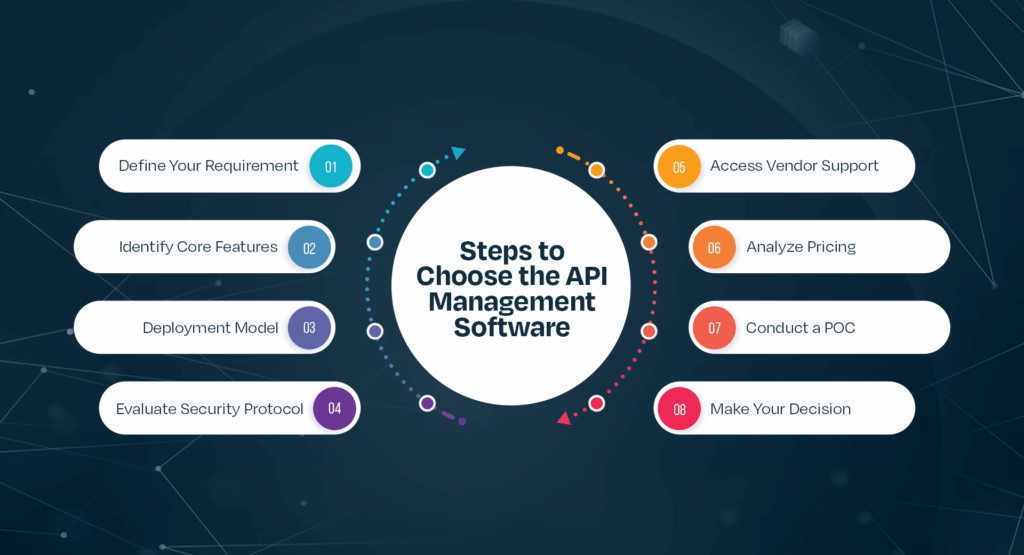With every new integration and service, managing them becomes more complex. Security gaps widen, performance takes a hit, and your developers are left navigating a tangled web of endpoints and errors. Without a solid management strategy, it’s not just messy – it’s risky.
The fix? API Management Platforms.
This is your definitive 2025 guide.
This guide will walk you through how an API management platform can bring order, control, and confidence to your growing API ecosystem.
Let’s dive in.
What Exactly is API Management Platform?
Think of API Management Software as the central control tower for your organization’s entire API ecosystem.
It’s not just a single tool but rather a suite of integrated tools and services. In fact, according to Microsoft Azure, it enables organizations to create, secure, publish, manage, monitor, and analyze APIs throughout their lifecycle.
Just as air traffic control manages airplanes – ensuring they follow routes, maintain safe distances, land securely, and operate efficiently – API management governs the flow of data and requests through your APIs.
Moreover, API management software provides a unified interface and set of policies to handle everything related to your APIs. Whether they are internal (used by your own applications), external (used by partners), or public (open to third-party developers), you’re set.
While an API Gateway is a critical component of API management (handling request routing, security enforcement, rate limiting at runtime), it’s only one piece of the puzzle. True API management encompasses the entire lifecycle and strategy around APIs. Asterdio can help your organization to manage your complex digital ecosystem.
Core Components of API Management Platforms:
Most comprehensive API management tools include these key building blocks:
1. API Gateway:
The runtime engine and policy enforcement point. It intercepts all incoming API requests, authenticates them, enforces security policies, routes requests to the appropriate backend services, and sometimes performs transformations.
2. Developer Portal:
The front door for developers who want to use your APIs. It provides API documentation, code samples, SDKs, interactive consoles for testing, forums, and tools for developers to register, get API keys, and manage their usage. A great developer portal significantly improves the developer experience (DX).
3. API Lifecycle Management:
Tools to manage the entire journey of an API. This includes initial design and development to testing, deployment, versioning, promotion through different environments, and eventual retirement. This ensures consistency and control.
4. Analytics and Monitoring:
Dashboards and reporting tools that provide visibility into API usage, performance, errors, latency, security threats, and adherence to SLAs. This helps understand how APIs are being used, identify bottlenecks, and make data-driven decisions.
5. Policy and Security Management:
A centralized system for defining, managing, and enforcing security policies and operational policies across all APIs.
Understanding these components helps to grasp the breadth and depth of what API management platform offers beyond simple request routing.

Why API Management Is Non-Negotiable in 2025: The Key Benefits
Implementing a robust API management solution isn’t just a technical upgrade; it’s a strategic imperative with tangible business benefits.
Here’s why it’s crucial:
- Rock-Solid Security:
APIs are potential entry points for attackers. API management provides centralized control to enforce various things. For instance, authentication, authorization, encryption, and threat protection policies consistently, significantly reduce your attack surface. It helps prevent data breaches and ensure compliance.
- Enhanced Scalability and Performance:
API gateways can handle traffic spikes, perform load balancing, and implement caching strategies. This ensures your backend services aren’t overwhelmed and your APIs remain responsive.
- Streamlined Governance and Compliance:
Centralized policy management ensures all APIs adhere to internal standards and external regulations. It provides an audit trail for API access and changes, simplifying compliance efforts.
- Accelerated Developer Productivity:
A good developer portal makes it easy for developers to find, understand, and consume APIs quickly. Self-service key provisioning, interactive documentation, and SDKs drastically reduce onboarding time. Additionally, it also supports overhead, freeing up developers to build applications faster.
- Enabling API Monetization:
Want to charge for API access? Management platforms provide tools to define different usage plans, setting specific quotas and rate limits for each tier.They also enable detailed usage tracking and offer integrations with billing systems. This opens up new revenue streams.
- Driving Innovation and Agility:
By making APIs easily discoverable, reusable, and secure, API management fosters innovation. Teams can leverage existing capabilities instead of reinventing the wheel. Consequently, you’ll have faster development of new products, services, and integrations. It supports microservices architectures and digital transformation initiatives.
- Centralized Visibility and Insights:
Comprehensive analytics provide deep insights into how your APIs are performing and being used. This helps identify popular APIs, troubleshoot issues proactively, understand consumer behavior, and measure the business impact of your API program.
- Improved Partner Integration:
Simplifies the process of securely exposing APIs to business partners, fostering collaboration, and creating new ecosystem opportunities.
Bottom line: Effective API management transforms APIs from a technical necessity into a strategic business driver.
Must-Have Features: What to Look For in API Management Platform
When evaluating different API management solutions, focus on features that align with your specific needs. However, certain capabilities are fundamental:
1. Robust API Gateway Functionality:
- Protocol Support: REST, SOAP, GraphQL, WebSocket support.
- Request/Response Transformation: Ability to modify requests and responses (e.g., change formats, filter data).
- Traffic Management: Rate limiting, spike arrests, quotas, load balancing, caching.
- Policy Enforcement: Applying security, traffic, and custom policies.
- Mediation & Routing: Directing traffic to appropriate backend services based on rules.
2. Comprehensive Security Features:
- Authentication: Support for various standards (OAuth 2.0, OpenID Connect, JWT, SAML, API Keys, Mutual TLS).
- Authorization: Fine-grained access control based on roles and permissions.
- Threat Protection: Defenses against common API attacks (OWASP API Security Top 10), including JSON/XML payload validation, SQL/code injection prevention.
- Encryption: Support for TLS/SSL for data in transit.
- Secrets Management: Secure handling of credentials and keys.
3. Powerful Developer Portal:
- Self-Service Onboarding: Easy registration for developers and applications.
- API Documentation: Automated generation from specs (OpenAPI/Swagger, RAML), interactive consoles (“Try it out” functionality).
- SDK Generation: Tools to automatically generate client Software Development Kits (SDKs) in various languages.
- API Catalog: Searchable and browsable catalog of available APIs.
- Usage Analytics: Dashboards for developers to track their own API consumption.
- Forums & Support: Community features for collaboration and help.
4. Insightful Analytics and Monitoring:
- Real-time Dashboards: Monitoring API traffic, latency, error rates, and overall health.
- Historical Reporting: Analyzing trends, usage patterns, and performance over time.
- Alerting: Configurable alerts for anomalies, errors, or policy violations.
- Log Aggregation & Search: Centralized logging for troubleshooting.
- Business Metrics: Tracking metrics tied to business goals (e.g., API calls per partner, revenue generated).
5. Full API Lifecycle Management:
- API Design Tools: Support for designing APIs, potentially integrated with spec formats.
- Version Control: Managing multiple versions of an API simultaneously.
- Environment Promotion: Controlled deployment across development, staging, and production.
- Testing Integration: Hooks or capabilities to integrate with automated testing frameworks.
- Deprecation & Retirement: Gracefully retiring older API versions.
6. Flexible Policy Management:
- Centralized Policy Definition: A user-friendly interface to create and manage policies.
- Policy Reusability: Applying common policies across multiple APIs.
- Custom Policy Development: Ability to create custom policies specific to your needs (often via code or scripting).
7. Monetization Capabilities (If Applicable):
- Rate Plan Management: Defining different tiers of access with varying quotas, rates, and features.
- Usage Tracking & Metering: Accurately tracking consumption per developer or application.
- Billing Integration: Hooks or connectors to integrate with payment gateways and billing systems.
8. Deployment and Architecture:
- Deployment Options: Support for Cloud (SaaS), On-Premises, Hybrid, and Multi-Cloud deployments.
- Scalability & High Availability: The SaaS Architecture is designed for resilience and scaling.
- Containerization Support: Compatibility with Docker, Kubernetes.
Evaluate these features based on your current requirements and anticipated future needs.
How to Choose the Right API Management Platform: A Step-by-Step Approach
Selecting the right API management platform is a critical decision. Rushing this can lead to wasted investment and technical debt. Follow these steps for a structured evaluation:
- Define Your Requirements Clearly:
- Use Cases: What problems are you trying to solve? (e.g., secure mobile apps, build a partner ecosystem, modernize legacy systems, enable internal microservices communication).
- Scale: How many APIs do you have now? How many do you expect in 1-3 years? What are your anticipated traffic volumes (requests per second)?
- Technical Landscape: What is your existing infrastructure (cloud providers, on-prem servers, authentication systems)? What technologies do your backend services use?
- Team Skills: What expertise does your team have (DevOps, security, specific programming languages)?
- Compliance Needs: Are you subject to specific industry regulations (HIPAA, PCI DSS, GDPR)?
- Identify Core Feature Needs: Based on your requirements, prioritize the features listed in the previous section. Which are non-negotiable? Which are nice-to-have? Don’t assume you need every feature from day one.
- Consider the Deployment Model:
- Cloud (SaaS): Fastest time-to-market, managed infrastructure, typically subscription-based. Less control over underlying infrastructure.
- On-Premises: Full control over data and infrastructure, potentially higher upfront costs and operational overhead. Necessary for certain compliance or data residency requirements.
- Hybrid: Combines cloud-based management plane with on-premise or private cloud gateways. Offers flexibility but can add complexity.
- Multi-Cloud: Ability to deploy gateways across different cloud providers while managing centrally.
- Evaluate Security and Compliance Thoroughly: This is paramount. Dig deep into the platform’s security features, certifications, and how it helps meet your specific compliance mandates.
- Assess Vendor Support, Community, and Roadmap:
- What levels of technical support are offered? What are the SLAs?
- Is there an active user community (forums, documentation, tutorials)?
- What is the vendor’s track record and future product roadmap? Are they innovating?
- Analyze Pricing Models: Understand the costs involved. Pricing can be based on various factors: number of API calls, number of managed APIs, features used, number of environments, support levels. Model your expected usage to estimate total cost of ownership (TCO). Beware of hidden costs.
- Shortlist Vendors and Conduct a Proof of Concept (POC):
- Based on your research, select 2-3 vendors that seem like the best fit.
- Define specific scenarios and success criteria for a POC.
- Get hands-on experience with the platforms. Test key features, usability, performance, and ease of integration with your existing systems. Involve your technical teams (developers, operations, security) in the evaluation.
- Make Your Decision: Choose the platform that best meets your technical requirements, business goals, budget, and usability needs, based on the evidence gathered during the POC.
Don’t underestimate the importance of the POC phase. Actually using the software is the best way to determine if it’s the right fit.

The Future of API Management: What’s Next?
API management continues to evolve alongside broader technology trends:
- AI and Machine Learning: Expect more AI/ML integration for automated security threat detection, anomaly detection in traffic patterns, intelligent API design suggestions, and predictive analytics.
- GraphQL, gRPC, and AsyncAPI Support: Platforms are expanding beyond REST/SOAP to provide first-class support for other API styles like GraphQL, event-driven APIs (AsyncAPI, WebSockets), and gRPC, reflecting their growing adoption.
- Service Mesh Integration: Closer integration with service mesh technologies (like Istio, Linkerd) for managing east-west (internal microservice) traffic alongside north-south (external) traffic, providing unified observability and policy enforcement.
- Enhanced Security: Continuous focus on sophisticated security measures, including advanced bot detection, behavioral analysis, and tighter integration with identity and access management (IAM) systems.
- Declarative Configuration (GitOps): Managing API configurations and policies as code stored in Git repositories, enabling version control, automation, and better collaboration (APIOps).
- Focus on Business Outcomes: Shifting analytics from purely technical metrics to measuring the direct business value and outcomes driven by APIs.
Staying aware of these trends can help future-proof your API strategy.
Conclusion: Take Control of Your API Ecosystem
In today’s interconnected digital landscape, APIs are the foundation of innovation, agility, and new business models. But unmanaged APIs quickly lead to security vulnerabilities, performance issues, duplicated effort, and missed opportunities.
API management software is the essential toolkit for bringing order to API chaos. It provides the necessary controls for securing, publishing, monitoring, and analyzing your APIs throughout their life cycle. From robust gateways and developer-friendly portals to insightful analytics and lifecycle governance, these platforms empower organizations to:
- Secure their digital assets.
- Scale their operations reliably.
- Govern their API landscape effectively.
- Accelerate development and innovation.
- Unlock new business value through API products and ecosystems.
Choosing the right platform requires careful consideration of your specific needs, technical environment, and business goals. By following a structured evaluation process and prioritizing key features, you can select a solution that transforms your APIs into well-managed, strategic assets.
Don’t let API complexity hold you back. It’s time to invest in managing your APIs strategically.



